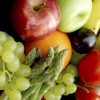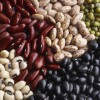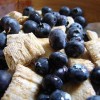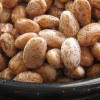 Los frijoles, los guisantes y las lentejas son conocidos colectivamente como legumbres. Los frijoles son una gran fuente de muchos nutrientes, incluyendo proteína, fibra y potasio. This 2-page fact sheet was written by Lakshmi Mahan, Lauren Foster, and Wendy J. Dahl, and published by the UF Department of Food Science and Human Nutrition, January 2014.
Los frijoles, los guisantes y las lentejas son conocidos colectivamente como legumbres. Los frijoles son una gran fuente de muchos nutrientes, incluyendo proteína, fibra y potasio. This 2-page fact sheet was written by Lakshmi Mahan, Lauren Foster, and Wendy J. Dahl, and published by the UF Department of Food Science and Human Nutrition, January 2014.
http://edis.ifas.ufl.edu/fs240
Tag: Lauren Foster
Facts about Fructose
 Fructose is a simple sugar found in many foods. Common table sugar is made of equal amounts fructose and glucose. Similarly, high-fructose corn syrup, commonly used to sweeten foods, contains a mixture of fructose and glucose. Fructose is sweeter than glucose, and for this reason it has been used in many sweetened foods. This 2-page fact sheet was written by Wendy Dahl, Lauren Foster, and Russel Owen, and published by the UF Department of Food Science and Human Nutrition, June 2013.
Fructose is a simple sugar found in many foods. Common table sugar is made of equal amounts fructose and glucose. Similarly, high-fructose corn syrup, commonly used to sweeten foods, contains a mixture of fructose and glucose. Fructose is sweeter than glucose, and for this reason it has been used in many sweetened foods. This 2-page fact sheet was written by Wendy Dahl, Lauren Foster, and Russel Owen, and published by the UF Department of Food Science and Human Nutrition, June 2013.
http://edis.ifas.ufl.edu/fs148
Beans, Peas, and Lentils: Health Benefits (FSHN1306/FS229)
 Bean, peas, and lentils are known collectively as legumes or pulses. Beans are great sources of many nutrients, including protein, fiber, and potassium. They can be placed either in the vegetable group or the protein group of MyPlate. If you have consumed enough protein choices, then you can count them in the vegetable group, and vice versa. This 2-page fact sheet was written by Lakshmi Mahan, Lauren Foster, and Wendy J. Dahl, and published by the UF Department of Food Science and Human Nutrition, May 2013.
Bean, peas, and lentils are known collectively as legumes or pulses. Beans are great sources of many nutrients, including protein, fiber, and potassium. They can be placed either in the vegetable group or the protein group of MyPlate. If you have consumed enough protein choices, then you can count them in the vegetable group, and vice versa. This 2-page fact sheet was written by Lakshmi Mahan, Lauren Foster, and Wendy J. Dahl, and published by the UF Department of Food Science and Human Nutrition, May 2013.
http://edis.ifas.ufl.edu/fs229
El sobrepeso y el mantenimiento de la perdida de peso (FSHN1304S/FS228)
 Para muchas personas, la pérdida de peso es una batalla crónica. Las dietas populares a menudo son poco exitosas porque no se pueden seguir de forma permanente. No hay una dieta mágica que le pueda hacer bajar de peso inmediatamente, pero a continuación se enumeran algunos buenos consejos para la pérdida de peso de una manera estable y de largo plazo. This 3-page fact sheet was written by Anne Mathews, Lauren Foster, and Wendy Dahl, and published by the UF Department of Food Science and Human Nutrition, April 2013.
Para muchas personas, la pérdida de peso es una batalla crónica. Las dietas populares a menudo son poco exitosas porque no se pueden seguir de forma permanente. No hay una dieta mágica que le pueda hacer bajar de peso inmediatamente, pero a continuación se enumeran algunos buenos consejos para la pérdida de peso de una manera estable y de largo plazo. This 3-page fact sheet was written by Anne Mathews, Lauren Foster, and Wendy Dahl, and published by the UF Department of Food Science and Human Nutrition, April 2013.
http://edis.ifas.ufl.edu/fs228
Overweight and Weight Loss Maintenance (FSHN1304/FS226)
 For many people, weight loss is a chronic battle. Popular diets are often unsuccessful because they cannot be followed permanently. There is no magic diet to make you instantly shed pounds, but some good tips for steady, long-term weight loss are listed in this 2-page fact sheet written by Anne Mathews, Lauren Foster, and Wendy Dahl, and published by the UF Department of Food Science and Human Nutrition, February 2013.
For many people, weight loss is a chronic battle. Popular diets are often unsuccessful because they cannot be followed permanently. There is no magic diet to make you instantly shed pounds, but some good tips for steady, long-term weight loss are listed in this 2-page fact sheet written by Anne Mathews, Lauren Foster, and Wendy Dahl, and published by the UF Department of Food Science and Human Nutrition, February 2013.
http://edis.ifas.ufl.edu/fs226
De compras para la salud: Sodio (FSHN1006S/FS211)
 El sodio es un mineral que se encuentra en la sal de mesa. Es necesario para mantener un balance de fluidos y el volumen de sangre. El consumo excesivo de sodio puede causar presión alta en la sangre e incrementar el riesgo de enfermedades del corazón y derrames cerebrales. This 4-page fact sheet was written by Wendy J. Dahl y Lauren Foster, and published by the UF Department of Food Science and Human Nutrition, March 2013.
El sodio es un mineral que se encuentra en la sal de mesa. Es necesario para mantener un balance de fluidos y el volumen de sangre. El consumo excesivo de sodio puede causar presión alta en la sangre e incrementar el riesgo de enfermedades del corazón y derrames cerebrales. This 4-page fact sheet was written by Wendy J. Dahl y Lauren Foster, and published by the UF Department of Food Science and Human Nutrition, March 2013.
http://edis.ifas.ufl.edu/fs211
De compras para salud: Granos integrales (FSHN1013S/FS217)
 Los granos incluyen alimentos como el pan, la pasta, la avena, y las galletas. Cualquier alimento hecho con trigo, avena, arroz, maíz, cebada u otro cereal es considerado un grano. Sustituir los productos refinados por los de granos integrales puede ayudar con el manejo del peso y a disminuir el riesgo de enfermedades crónicas. This 4-page fact sheet was written by Food Science and Human Nutrition, and published by the UF Department of Wendy J. Dahl y Lauren Foster, January 2013.
Los granos incluyen alimentos como el pan, la pasta, la avena, y las galletas. Cualquier alimento hecho con trigo, avena, arroz, maíz, cebada u otro cereal es considerado un grano. Sustituir los productos refinados por los de granos integrales puede ayudar con el manejo del peso y a disminuir el riesgo de enfermedades crónicas. This 4-page fact sheet was written by Food Science and Human Nutrition, and published by the UF Department of Wendy J. Dahl y Lauren Foster, January 2013.
http://edis.ifas.ufl.edu/fs217
De compras para la salud: Frijoles, guisantes y lentejas (FSHN1105S/FS201)
 Las legumbres son unos de los alimentos más completos en la naturaleza que proveen una gran variedad de beneficios para la salud. Las legumbres tienen mucha proteína, fibra y vitaminas. También son bajas en grasa, no tienen colesterol y son muy bajas en grasa saturada. Los frijoles oscuros tienen alto contenido de antioxidantes. This 4-page fact sheet was written by Lakshmi Mahan, Lauren Foster y Wendy J. Dahl, and published by the UF Department of Food Science and Human Nutrition, October 2012.
Las legumbres son unos de los alimentos más completos en la naturaleza que proveen una gran variedad de beneficios para la salud. Las legumbres tienen mucha proteína, fibra y vitaminas. También son bajas en grasa, no tienen colesterol y son muy bajas en grasa saturada. Los frijoles oscuros tienen alto contenido de antioxidantes. This 4-page fact sheet was written by Lakshmi Mahan, Lauren Foster y Wendy J. Dahl, and published by the UF Department of Food Science and Human Nutrition, October 2012.
http://edis.ifas.ufl.edu/fs201
De compras para la salud: Leche (FSHN1109S/FS200)
 La leche ofrece una variedad de nutrientes esenciales que el cuerpo necesita para mantenerse saludable. Estos nutrientes incluyen el calcio, la vitamina D, la vitamina A y el potasio. La leche también contiene proteína de alta calidad que ayuda a satisfacer las necesidades de su cuerpo. This 4-page fact sheet was written by Wendy J. Dahl and Lauren Foster, and published by the UF Department of Food Science and Human Nutrition, October 2012.
La leche ofrece una variedad de nutrientes esenciales que el cuerpo necesita para mantenerse saludable. Estos nutrientes incluyen el calcio, la vitamina D, la vitamina A y el potasio. La leche también contiene proteína de alta calidad que ayuda a satisfacer las necesidades de su cuerpo. This 4-page fact sheet was written by Wendy J. Dahl and Lauren Foster, and published by the UF Department of Food Science and Human Nutrition, October 2012.
http://edis.ifas.ufl.edu/fs200
De compras para la salud: Dietas Vegetarianas (FSHN1106S/FS194)
 Las dietas vegetarianas bien balanceadas pueden ser nutritivas y ofrecen una variedad de beneficios para la salud. Los vegetarianos son menos propensos a generar enfermedades crónicas como la diabetes, hipertensión, enfermedades coronarias y ciertos tipos de cáncer. Pero los vegetarianos tienen un riesgo mayor de sufrir muchas deficiencias de nutrientes, incluyendo el hierro, la vitamina B12, el calcio y el zinc. This 4-page fact sheet was written by Lauren Foster and Wendy J. Dahl, and published by the UF Department of Food Science and Human Nutrition, June 2012.
Las dietas vegetarianas bien balanceadas pueden ser nutritivas y ofrecen una variedad de beneficios para la salud. Los vegetarianos son menos propensos a generar enfermedades crónicas como la diabetes, hipertensión, enfermedades coronarias y ciertos tipos de cáncer. Pero los vegetarianos tienen un riesgo mayor de sufrir muchas deficiencias de nutrientes, incluyendo el hierro, la vitamina B12, el calcio y el zinc. This 4-page fact sheet was written by Lauren Foster and Wendy J. Dahl, and published by the UF Department of Food Science and Human Nutrition, June 2012.
http://edis.ifas.ufl.edu/fs194
Los hechos acerca de la fructosa (FSHN1001S/FS184)
La fructosa es un azúcar simple que se encuentra en muchas comidas. Azúcar común de mesa está hecha por cantidades iguales de fructosa y glucosa. La fructosa es más dulce que la glucosa y por esta razón, ha sido usada en muchos alimentos endulzados.
This 2-page fact sheet is the Spanish language version of “Facts about Fructose.” It was written by Wendy J. Dahl, Lauren Foster y Russel J. Owen, and published by the UF Department of Food Science and Human Nutrition, January 2012.
http://edis.ifas.ufl.edu/fs184
Shopping for Health: Vegetarian Diets (FSHN1106/FS167)
 Well-balanced vegetarian diets can be nutritious and provide a variety of health benefits, but they are at higher risk for several nutrient deficiencies, including iron, vitamin B12, calcium, and zinc. This 6-page fact sheet lists foods that are rich in these nutrients. Written by Lauren Foster and Wendy J. Dahl , and published by the UF Department of Food Science and Human Nutrition, June 2011. (photo courtesy of elenaspantry.com)
Well-balanced vegetarian diets can be nutritious and provide a variety of health benefits, but they are at higher risk for several nutrient deficiencies, including iron, vitamin B12, calcium, and zinc. This 6-page fact sheet lists foods that are rich in these nutrients. Written by Lauren Foster and Wendy J. Dahl , and published by the UF Department of Food Science and Human Nutrition, June 2011. (photo courtesy of elenaspantry.com)
http://edis.ifas.ufl.edu/fs167
Shopping for Health: Beans, Peas, and Lentils (FSHN1105/FS166)
 Beans are one of the most wholesome foods in nature. They come packed with protein, fiber, and vitamins. Naturally low in fat, they contain no cholesterol and are very low in saturated fat. Some are also high in antioxidants. This 4-page fact sheet provides nutritional information and recipes. Written by Lakshmi Mahan, Lauren Foster, and Wendy J. Dahl, and published by the UF Department of Food Science and Human Nutrition, June 2011. (photo by nemka)
Beans are one of the most wholesome foods in nature. They come packed with protein, fiber, and vitamins. Naturally low in fat, they contain no cholesterol and are very low in saturated fat. Some are also high in antioxidants. This 4-page fact sheet provides nutritional information and recipes. Written by Lakshmi Mahan, Lauren Foster, and Wendy J. Dahl, and published by the UF Department of Food Science and Human Nutrition, June 2011. (photo by nemka)
http://edis.ifas.ufl.edu/fs166
Shopping for Health: Milk (FSHN1109/FS170)
 Consuming milk and milk products can provide many long-term health benefits, but you should know the facts before you shop. Not all types of milk provide the same nutrients. Learn more in this 4-page fact sheet written by Wendy J. Dahl and Lauren Foster, and published by the UF Department of Food Science and Human Nutrition, June 2011.
Consuming milk and milk products can provide many long-term health benefits, but you should know the facts before you shop. Not all types of milk provide the same nutrients. Learn more in this 4-page fact sheet written by Wendy J. Dahl and Lauren Foster, and published by the UF Department of Food Science and Human Nutrition, June 2011.
http://edis.ifas.ufl.edu/fs170
Nutriente energía y densidad (FSHN1112S/FS177)
Foods for the older adult that has lost weight should target both energy and nutrient density. This 1-page Spanish language fact sheet provides explanation and examples. Written by Wendy J. Dahl and Lauren Foster, and published by the UF Department of Food Science and Human Nutrition, May 2011.
http://edis.ifas.ufl.edu/fs177
Energy and Nutrient Density (FSHN1112/FS176)
Foods for the older adult that has lost weight should target both energy and nutrient density. This 1-page fact sheet provides explanation and examples. Written by Wendy J. Dahl and Lauren Foster, and published by the UF Department of Food Science and Human Nutrition , May 2011.
http://edis.ifas.ufl.edu/fs176
De compras para la salud: La vitamina D (FSHN1102S/FS175)
Vitamin D needs can be met by eating foods containing Vitamin D and taking vitamin supplements, but few foods are consistent in their levels of vitamin D. This 7-page Spanish language fact sheet will help you be an informed shopper and find brands that meet your vitamin D needs. Written by Lauren Foster and Wendy J. Dahl, and published by the UF Department of Food Science and Human Nutrition, May 2011.
http://edis.ifas.ufl.edu/fs175
Shopping for Health: Vitamin D (FSHN1102/FS163)
Vitamin D needs can be met by eating foods containing Vitamin D and taking vitamin supplements, but few foods are consistent in their levels of vitamin D. This 6-page fact sheet will help you be an informed shopper and find brands that meet your vitamin D needs. Written by Lauren Foster and Wendy J. Dahl, and published by the UF Department of Food Science and Human Nutrition, May 2011.
http://edis.ifas.ufl.edu/fs163
FSHN1013/FS161 Shopping for Health: Whole Grains
FSHN1013, a 4-page illustrated fact sheet by Wendy J. Dahl and Lauren Foster, describes the difference betweeb whole grains and refined grains, how many grains we need, and how to shop for foods that contain whole grains. Contains references. Published by the UF Department of Food Science and Human Nutrition, November 2010.
http://edis.ifas.ufl.edu/fs161
FSHN10-06/FS154 Shopping for Health: Sodium
FSHN10-06, a 4-page illustrated fact sheet by Wendy J. Dahl and Lauren Foster, provides information about sodium and offers tips on lowering sodium for a healthy diet. Includes references. Published by the UF Department of Food Science and Human Nutrition, July 2010.
http://edis.ifas.ufl.edu/fs154